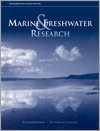Marine and Freshwater Research
Volume 72
Number 12 2021
Calcareous macroalgae play critical roles in coral reef ecosystems and contribute to the carbon cycle. We review the literature on and process of calcification in marine macroalgae from physiological and molecular standpoints. Potential effects of ocean acidification and warming on macroalgal calcification are reviewed to predict future changes to calcified macroalgae and ecological processes. This review identifies a lack of research on the topic, and highlights how overarching knowledge gaps can be filled by future studies.
Sea urchins can play a critical ecological role in the functioning of marine benthic ecosystems, mediating competitive interactions between corals and algae. Yet, little is known about factors affecting urchin distribution in intact coral reef systems. This study determines the spatial distribution and occurrence of two sympatric urchin species, Echinometra mathaei and Echinostrephus molaris, and the potential factors contributing to this, within the Ningaloo Marine Park.
The vulnerability of water resources to the impacts of climate change is not simply determined by geographic location. It is also influenced by how water users and local communities are coping with climate-change impacts. This article examines adaptation practices focused on tackling CyanoHABs occurrence in developing economies under changing climate.
Determining the population structure of aquatic species, especially those with small population sizes or those that are threatened and endangered is critical, yet challenging. For the first time, using new, novel genetic markers, we determined the population structure of one of Australia’s rarest endemic marine fish, spotted handfish (Brachionichthys hirsutus). We found that spatial populations of spotted handfish should be managed separately.
Coastal freshwater wetlands (CFWs) are important ecosystems in coastal landscapes but face serious threats from climate change. Baseline knowledge of their vegetation communities is lacking for many regions. We provide an assessment of CFW vegetation in south-east Queensland, Australia, highlighting the importance of salinity, rainfall, groundwater, and disturbance gradients for patterns in vegetation structure and composition. Projected climate changes will alter these gradients, which could lead to dramatic effects on CFWs.
Mixoplanktonic algae may link important aspects of aquatic food webs, because they both provide energy to higher trophic levels as photosynthetic producers, and also consume bacteria involved in microbial recycling processes. We used in situ mesocosm experiments to assess the role of phosphorus, light and bacterial availability on the relative abundance and biomass of mixotrophic taxa in a highly stained lake. Our results indicated that phosphorus concentrations may be the primary driver of mixotrophic dynamics in such systems.
The development of a breeding protocol for G. brasiliensis is of interest to the aquarium trade. This study aims to provide more information about the behaviour of G. brasiliensis in captivity, testing pair and harem formation, as well as the choice of different macroalgae and synthetic materials for nest building, and describing courtship behaviour. G. brasiliensis should be kept in pairs; macroalgae of the genus Chaetomorpha and synthetic materials are used for nest building, and we provide the first description of the courtship behaviour of G. brasiliensis in captivity.
High particulate organic carbon (POC) concentrations were found mainly at the coastal and continental shelves connected to estuaries. The seasonal pattern of POC shows highest levels during the south-east monsoon and lowest levels during the north-west monsoon. The combination of natural physicochemical processes and anthropogenic perturbations has significant effects on spatial and temporal variations in POC. The MODIS product of POC underestimates the actual POC in the region of the Halmahera Sea and surrounds; thus, a regional algorithm is necessary for future studies.
This study provides information on the photosynthetic performance and litter production of planted and natural mangroves in Trang, southern Thailand. This study highlights the positive outcomes of mangrove restoration, particularly in degraded mangrove stands due to land use change.
This study evaluated changes in carbon and nitrogen stable isotope ratios (δ13C and δ15N) of small pelagic forage fish species. δ13C values declined drastically from 2005 to 2006, whereas δ15N values decreased gradually or were stable. Trends of δ13C and δ15N of forage fish species can be affected by the changes in baseline values owing to anthropogenic and primary production changes.
This paper investigated the relationship among the sightings of four stingray species and environmental and temporal variables in southern Mozambique. This included the smalleye stingray (Megatrygon microps), which is severely unknown to science. We compared trends among the species, discussing overlap and niche partitioning. We identified an area where all stingrays are found, lending itself to future studies and conservation. Last, we outline the training necessary for reliable, long-term data collection by citizen scientists.
Different seaweed species can fuse together at their bases. When this fusion happens between species that float well and species that do not float, it could help the non-floating species to travel long distances at sea. Such a rafting mechanism could explain why some non-floating species turn up in unexpected places.





